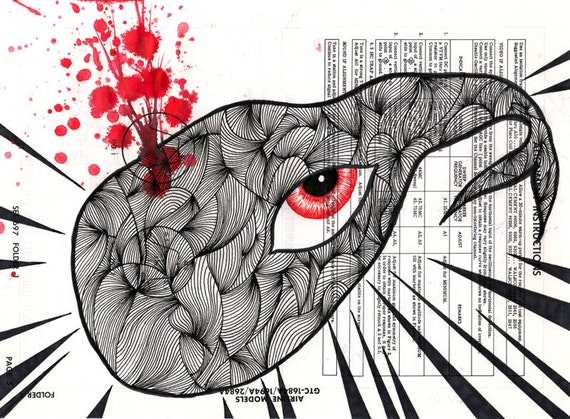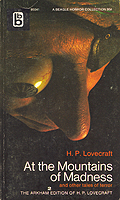 |
| Matt Kish, illustration for page 357 of Moby-Dick; or, The Whale, from his book Moby-Dick in Pictures: One Drawing for Every Page, October, 2011, Tin House Books. |
I was just in The Book Table in Oak Park and had to exercise great restraint to keep myself from "picking up" Matt Kish's Moby Dick in Pictures: One Drawing for Every Page. This book is now on The A List. What a fantastic, imagination-tickling, satisfying book. This big beauty would be a perfect gift for artists, sure, and for fans of Melville, literature generally, illustration, art, design, process, personal challenges. This book will delight a motley yet sophisticated lot of folks. The trailer from publisher Tin House gives a tasty taste:
Kish's undertaking is the fruit of an ambitious self-generated art prompt, and the proof in the prompt pudding. Prompts are just ideas laid out like scaffolding and this is the kind of project that can niggle a lot of fellow artists/writers toward conceiving some tapping framework to encourage the creative sugar sap to flow. Though not evidencing Kish's fab use of color, the image below is one of my favorite illustration/quote pairings, not in the least because it selects such wonderfully poetic lines to sketch (there are so many cool drawings, so there are lots of favorites):
 If you're not close to Oak Park's book Table, you can order Kish's leviathan direct from Tin House as well. And check out Kish's website, blog, and Etsy shop for projects, his notes on process, and wonderful art for sale at incredibly low prices. I was reading some of Kish's blog before posting on this and particularly enjoyed his posts on book covers (appearing first on the Tin House blog). Kish's love of vintage mass market fantasy covers comes through in the Moby-Dick illustrations. I love that his Dec. 16 post touts one of the H.P. Lovecraft covers that Annie Heckman included in her contributions to the Chicago Publishes What Makes a Beautiful (and Marketable) Book? forum I wrote on recently (I highlighted two of the other Mountains of Madness covers Heckman showed; Lovecraft obviously inspires visual artists).
If you're not close to Oak Park's book Table, you can order Kish's leviathan direct from Tin House as well. And check out Kish's website, blog, and Etsy shop for projects, his notes on process, and wonderful art for sale at incredibly low prices. I was reading some of Kish's blog before posting on this and particularly enjoyed his posts on book covers (appearing first on the Tin House blog). Kish's love of vintage mass market fantasy covers comes through in the Moby-Dick illustrations. I love that his Dec. 16 post touts one of the H.P. Lovecraft covers that Annie Heckman included in her contributions to the Chicago Publishes What Makes a Beautiful (and Marketable) Book? forum I wrote on recently (I highlighted two of the other Mountains of Madness covers Heckman showed; Lovecraft obviously inspires visual artists).I've run the clock down so my 12 Days of Christmas Books posts will serve multiple/overlapping category offerings these days. . . .
Also tempting at The Book Table, India: The Cookbook, the fourteenth cookbook authored by Professor Pushpesh Pant, is an appealingly big book in its own right, packed in a printed, rice-carrier-style bag. With heft and the great design that characterizes publisher Phaidon's catalog, India: The Cookbook covers all of India's diverse cuisine regions and compiles Pant's twenty years of culinary research. (Cookbook, big book, compendium.) The book garnered the award for 'Best Indian Cuisine Cookbook in the World' at the 2011 Gourmand Cookbook Awards.
Pant's newest also shared the NYT's list of the year's best cookbooks with At Home with Madhur Jaffrey. I have a few Indian cookbooks and like to cook Indian somewhat regularly. I've turned to my text-only Madhur Jaffrey's Spice Kitchen: An Introduction to Indian Spices in 50 Simple Recipes nineteen times out of twenty over the course of the last twenty years when cooking Indian; I usually require pics, but this little sampler has me and my other very fine Indian cookbooks sit on the shelf, perfectly clean, virtually unused. I have given Jaffrey's cookbooks as gifts many times. One friend still thanks me for his Jaffrey cookbook eight years later. So, experience tells me that I don't need a new Indian cookbook. Still, India handsomely commands immediate "must-have" status.
 |
| Fish in Red Chili Chutney, India: The Cookbook (via http://www.indiawest.com) |
The IndiaWest online community Web site features a few recipes from Pant's India; if you're finicky about cookbooks and not drawn in by looks alone you can try one or two dishes before committing. Make a warming winter fish dinner, using Great Lakes whitefish:
Fish in Red Chili Chutney
Origin: Coastal
Preparation time: 25-30 minutes, plus standing time
Cooking time: 15-20 minutes
Serves: 4
Ingredients:
1 lb 10 oz skinless, firm white fish fillets, trimmed
1 tablespoon vegetable oil
salt
For the marinade
1 level teaspoon ground turmeric*
4 cloves garlic, crushed
1 tablespoon lime juice
½ teaspoon sugar
For the red spice paste
6 dried red chilies
1/3 cup dried flake coconut
1 teaspoon malt (white) vinegar
* turmeric is a spice made from the rhizome of the turmeric plant,
which is ground to make a bright yellow powder. It has a warm, dry
flavour and is found in almost all curries and pickles. It also has
antiseptic properties.
Cooking Instructions:
Mix the turmeric, garlic, lime juice, sugar and a little salt
together in a bowl. Put the fish in a large shallow dish and rub the
fish with the turmeric mixture, then cover and set aside in the
refrigerator for 30 minutes.
To make the red spice paste, put the dried red chilies, desiccated
coconut and vinegar in a food processor or small blender and process to
make a paste, adding a little water only if necessary.
Heat the oil in a pan over high heat, add the red spice paste and
stir-fry lightly for about 1 minute, ensuring the bright red colour is
not lost due to browning. Reduce the heat, add the fish with ½ cup water, stir and simmer for 7-8 minutes, or until the
fish is cooked.












































